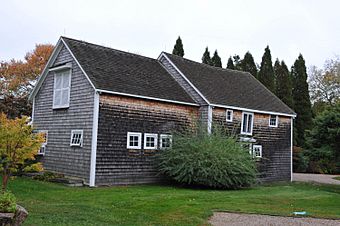William Gorton Farm facts for kids
Quick facts for kids |
|
|
William Gorton Farm
|
|

The horse barn
|
|
| Location | 14 West Lane, East Lyme, Connecticut |
|---|---|
| Area | 19.2 acres (7.8 ha) |
| Architectural style | Georgian |
| NRHP reference No. | 84001166 |
| Added to NRHP | April 5, 1984 |
The William Gorton Farm, also known as the Bond Farm, is a really old farm in East Lyme, Connecticut. It's located at 14 West Lane. For hundreds of years, from the late 1600s to the early 1900s, people used this land for farming.
Today, you can still see some of the original buildings. These include a farmhouse, two barns, and a blacksmith shop. There are also parts of an old icehouse and a dock. Because of its long history, the farm was added to the National Register of Historic Places on April 5, 1984.
A Look Back at the Farm's History
Early Days of the Farm
The story of the William Gorton Farm began in 1686. A man named Christopher Christophers bought a large piece of land. This area was then called Black Point. People believe he came from Barbados. The land was likely used to grow hay and feed for animals.
In 1723, the land passed to the Manwaring family through marriage. They probably used it to raise cattle. The farmhouse you see today was built later in the 1700s. Records from 1782 mention a house and farm buildings.
New Owners and New Uses
Robert Gorton bought the farm in 1817. Years later, in 1858, a dock was built on the property. This dock was used to load hay onto ships. These ships would then sail to the West Indies. Around 1869, the big red barn was built. The horse barn and blacksmith shop were also likely built around this time.
In 1874, Colonel Norman J. Bond bought the farm from William G. Gorton. Colonel Bond used part of the farm for a new project. He started a summer resort called Black Point Cottages. By the 1880s, many rich New Yorkers came to stay there.
Even though the trade with the West Indies slowed down, farming continued. The remaining part of the farm was used for dairy farming. This continued until the 1930s.



